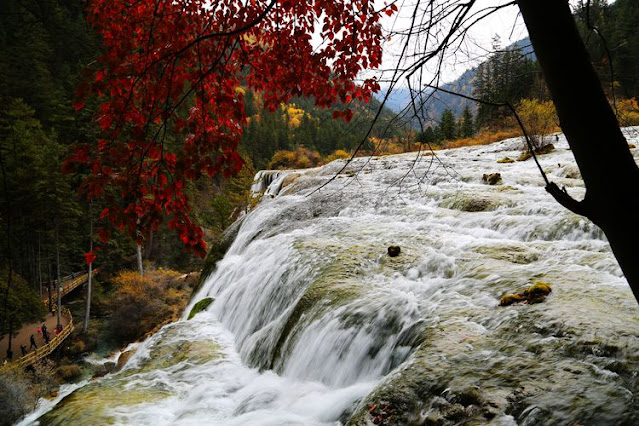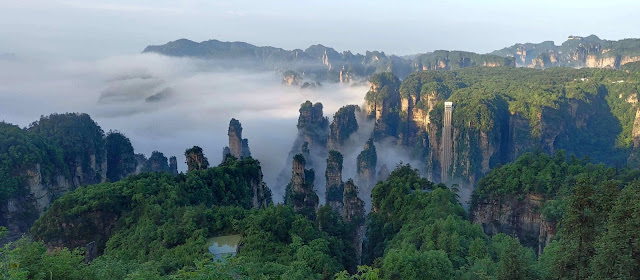Chinese Natural Landscapes
Jiuzhai Valley
Jiuzhai Valley, officially named Jiuzhai Valley National Park, is located in the Aba Tibetan and Qiang Autonomous Prefecture of Sichuan Province in southwestern China.The national park covers an area of more than 600 square kilometers (about 230 square miles) with a maximum altitude of more than 4,500 meters. Jiuzhai Valley literally means "Nine-Village Valley" in Chinese and is named after the nine villages scattered in the park. The valley was inhabited by various Tibetan and Qiang people for centuries, and some of the local people still hold onto their traditional ways of life. Jiuzhai Valley is a great masterpiece of nature with dreamlike scenery. Water is the soul of Jiuzhai Valley, with blue, green and turquoise-colored lakes being Jiuzhaigou's best-known feature. There are 114 individual lakes in the park, such as the Five Color Pool, the Panda Lake, the Arrow Bamboo Lake, the Five Flower Lake, the Long Lake and so on. There are 5 major waterfalls and numerous smaller waterfalls throughout the park, among which the Nuorilang Waterfall is the widest and most famous. The park is the habitat for two of China's most treasured endangered species-the Giant Panda and the Sichuan Golden Snub-Nosed Monkey.
Jiuzhai Valley is a National 5A tourist attraction, national nature reserve, and national geological park in 1992, it wais inscribed by UNESCO as a World Heritage Site.
Stone Forest of Kunming
The Stone Forest is a spectacular set of limestone formations located in Shilin Yi Autonomous County, Yunnan Province, China. Stone Forest Scenic Area of Kunming covers an area of 350 square kilometers. It is classified as a national 5A tourist site and named a "world geopark" by UNESCO. The scenic area includes seven parts: Greater & Lesser Stone Forests, Naigu Stone Forest , Zhiyun Cave, Long Lake, Moon Lake, Dadieshui Waterfall and Qifeng Cave.
Hulun Buir Grassland
Hulun Buir Grassland is located in Hailaer in the northeast of lnner Mongolia Autonomous Region in China. The terrain of Hulunbeier Grassland is high in the east and low in the west, with an altitude of 650 meters to 700 meters and a total area of about 100,000 square kilometers, which ranks it one of the four biggest grasslands in the world. Hulun Buir Grassland is the best-preserved grassland in China, with a meadow of more than 100 million acres, and more than 500 lakes and over 3,000 rivers. The Hulun Buir Grassland is known as the kingdom of pastureland. It is home to over 120 enriched pastures and more than 1,300 species of plants. Hulun Buir Grassland is named after Hulun Lake and Buir Lake. The Hulun Lake is the fourth largest freshwater lake and the fifth largest lake in China. Upstream in the south is Buir Lake, the boundary lake between China and Mongolia. There is a local legend of two young Mongolian lovers named Hulun and Buir, who rescued the grassland from evil spirits. The local people named the lakes and the grassland after them in honor of their courage and wisdom.
Besides its beautiful landscape the Hulun Buir Grassland also excels in meat, milk, fur and other livestock products, thanks to its grassland with no pollution. As the birthplace of Genghis Khan, it is also a world-famous tourist destination.
Xishuangbanna
Xishuangbanna, or Xishuangbanna Dai Autonomous Prefecture is located in the south of Yunnan Province of China, near the Thai, Laotian, Vietnamese and Burmese borders. It is a very attractive destination for tourists as well as important gateway to Southeast Asia. It is regarded as "the Kingdom of Animals and Plants", with lush tropical forest containing varied wild lives. Famous tourist attractions include Xishuangbanna Tropical Botanical Garden of Chinese Academy of Sciences, Mengle Great Buddha Temple, the Wild Elephant Valley, etc. Xishuangbanna Tropical Botanical Garden of Chinese Academy of Sciences is a distinguished research institution as well as a well-known scenic spot. It is the largest artificial botanical garden with the richest life forms in China. It is a national 5A tourist attraction and was awarded the honor of Best Chinese Botanic Garden in 2016.
Xishuangbanna is the home to Dai nationality that holds rich folk customs, for example, the water-splashing festival. During the festival, people splash water on each other in order to wash off dirt and bad luck of the past year and hope for blessings and happiness in the coming new year.
Guilin Scenery with Mountains and Waters
Guilin,covering an area of about 27,800 square kilometers, is located in the northeast of Guangxi Zhuang Autonomous Region in south China.The Chinese name of the city means "Forest of Osmanthus Trees",which is derived from the abundance of osmanthus trees in the city. In autumn,the tiny yellow flowers of osmanthus trees would fill the air with their exquisite fragrance.There is an ancient Chinese saying that "Guilin scenery is the best under heaven".It is renowned for its unique scenery of karst topography,tranquil rivers and mysterious caves.The Elephant Trunk Hillis the symbol and landmark of Guilin. Located at the confluence of the Taohua River and the Li River, the hill looks just like a giant elephant drinking water from the river with its trunk, hence the name the Elephant Trunk Hill.The Li River flowing through the city of Guilin is the highlight of sightseeing in Guilin.Tourists can go on the Li River cruise from Guilin to Yangshuo to enjoy the breathtaking scenery along the river.Tourists can also enjoy a large-scale landscape performance by the Li River, named Impression of Liu Sanjie.Other famous tourist attractions in Guilin include the Yulong River,the Yaoshan Hill,the Reed Flute Cave, the Crown Cave,the Jingjiang Princes' City of Ming Dynasty, the Ronghu Lake,the Shanhu Lake and so on.
With a history of more than 2,000 years,not only is Guilin one of the top tourist destinations in China for its natural beauty and cultural treasures but also a famous tourist attraction around the world.
Zhangjiajie
Zhangjiajie is a prefecture-level city located in the northwest of Hunan Province in China. It is one of the most popular tourist destinations renowned for its magnificent natural beauty.
The main attraction in Zhangjiajie is the Wulingyuan Scenic and Historic Interest Area. Wulingyuan Scenic Area comprises three parts: Zhangjiajie National Park, Suoxiyu Nature Reserve and Tianzi Mountain Natural Reserve, covering a total area of 135 square miles. The scenic area is noted for spectacular pillar-like sandstone formations, pristine streams and a wide variety of flora and fauna. Tourists can test their nerve by taking a walk on the Zhangjiajie Glass Bridge, which is a glass-bottomed transparent skywalk bridge, above the Wulingyuan area. It is 430 metres (1,410 ft) in total length and 6 metres (20 ft) in breadth, and is suspended about 300 metres (984 ft) above the ground. The highlight of the Wulingyuan Scenic Area-Zhangjiajie National Forest Park, is the first national forest park of China. The park is dominated by more than 3,100 narrow quartz and sandstone pillars and peaks, of which over 1,000 rise at least 650 feet.
Zhangjiajie was designated a UNESCO World Heritage Site in 1992 and was listed as a 5A scenic area by the China National Tourism Administration in 2007.
Changbai Mountain
Changbai Mountain is located in Antu County of Yanbian Korean Autonomous Prefecture in Jilin City Province in northeast China, bordering Democratic People's Republic of Korea. The name of Changbai Mountain means "a mountain which remains white all year round" in Chinese. The current name was first used in the Liao Dynasty ( 907AD-1125AD). The mountain was recorded in the Classic of Mountains and Seas under the name Buxian Mountain. It was called Taibai Mountain in the Tang Dynasty. Changbai Mountaain is the crafle of ethnic groups such as the Manchu and the Korean nationalities.
Changbai Mountain is s dormant volcano, boasting rate animals, marvelous lakes, amazing hot springs, and forests that stretch to the horizon. There is splendid scenery in the clearly-defined four seasons, and it is esprcially beautiful in winter. The whole mountain area is under solid snow cover for two months every year, and the higher peaks, which range from 1,500 meters to 2,400 meters above the sea level, are covered with snow for more than six months annually. The most beautiful scenic spot of Chiangbai Mountain is undoubtedly the Tianchi Lake of Heavenly Lake. It is a large crater lake in the caldera atop the mountain formed in a major eruption. With a surface area of 9.82 km², average depth of 213 m and maximum depth of 384 m, it is the deepest alpine lake in China. The Tianchi Lake is the source of the Songhua, Tumen and Yalu rivers and has been regaeded as a mysterious an holy lake.
Changbai Mountain is one of the "Top Q0 Mountains in China" and a National Nature Reserve. Being a popular tourist destination for vistors, it is classified as a 5A scenic area by the China National Tourism Administration.


























No comments